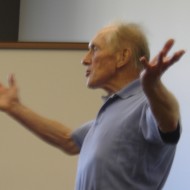According to a story in the Washington Post, mounting scientific evidence shows that sitting for long periods of time can lead to poor circulation, heart disease, and joint pain. Unfortunately, many American adults sit for approximately eight hours a day on the job. However, a recent study at Indiana University showed that five-minute walking breaks reversed some of the negative effects of prolonged sitting, especially when integrated into the working day.
This study supports Rudolf Laban’s notion that working activities should be designed to incorporate active recuperation rather than passive rest periods or breaks. … Read More








